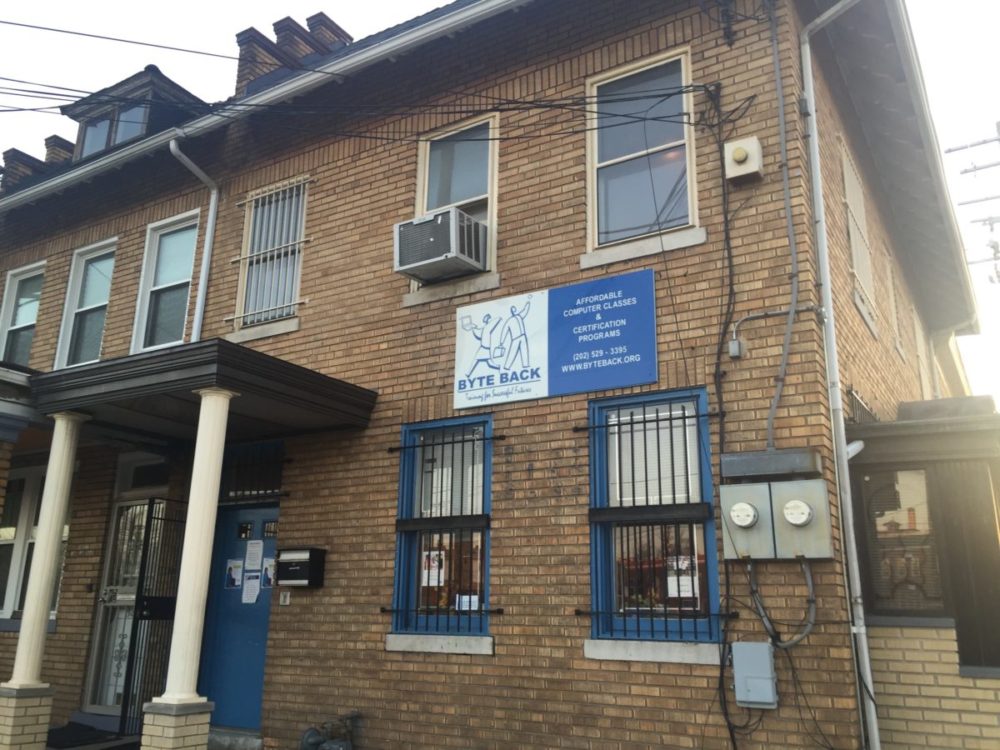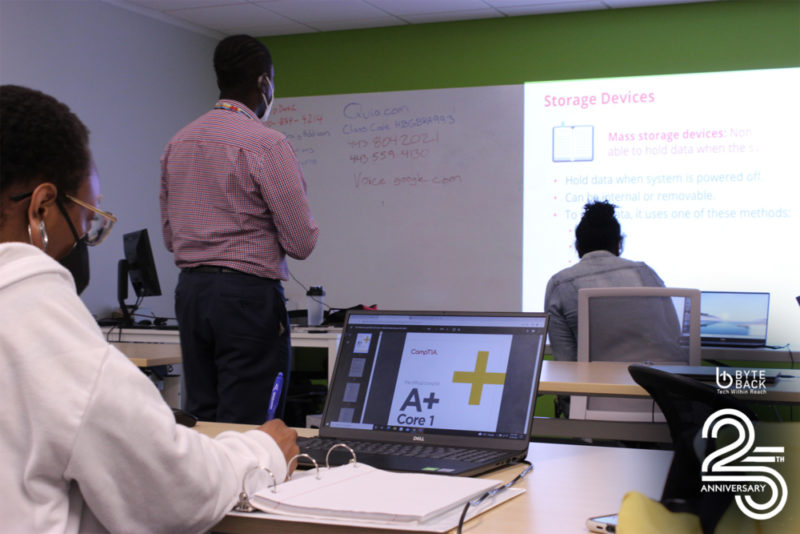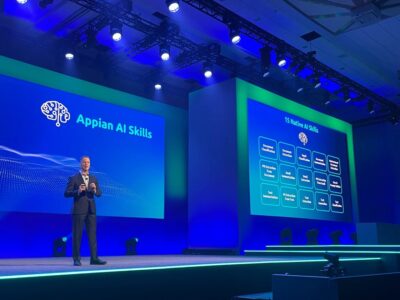He was just the guy that knew more about computers than anyone else at all of his previous jobs. He even managed to turn that knowledge into another position as a computer programmer on Wall Street.
“It’s something unique about the computer industry that all you need are the skills, not the professional background,” Stein told Technical.ly. “And that’s really different than any other white-collar career.”
Fast forward 25 years and the digital literacy nonprofit is still going strong in DC. It’s on track to upskill over 1,000 people before the end of the year. It expanded to nearby Baltimore. In May, the DC Chamber of Commerce named Byte Back its nonprofit of the year. And it’s about to host its very first gala tomorrow evening to honor its 25th anniversary.
But before all that, it was simply an idea that turned into a reality. Here’s a look at how it all began — and how it evolved throughout its quarter-century of life.
The beginnings

Byte Back’s HQ in Brookland. (Photo by Tajha Chappellet-Lanier)
Stein’s journey with Byte Back started when, after doing some work with the Reform Movement and the American Jewish World Service in Ethiopia, he returned stateside to find himself out of a job. After leveraging his tech skills, he landed the aforementioned Wall Street job with no formal training besides a single computer course he had taken at university.
It was then he realized that there was a tremendous opportunity for people without formal training or degrees to enter the high-paying tech workforce. Inspired, he looked for DC-based programs available for low-income residents interested in computer training, finding nothing significant. So, with the help of his friend Barbara Altman, Byte Back was created to fill the gap.
While it now provides educational programming in IT professions, Byte Back started just assisting DC residents with Microsoft and Excel basics (it still offers a Foundations course for beginners). It spent the first few years operating out of Stein’s house. It also offered an internship program where scholars would receive training in exchange for some compensation and staff posts.
The organization grew over the years, eventually moving into an official headquarters in Brookland. At one point, Stein even bought a building for eight interns to live in while they studied. And Byte Back, he said, continued to offer the training he felt was so necessary.
“It’s meant real, life-changing, quality training that was desperately needed,” Stein said. “I’m glad to see that Byte Back is filling that need.”
Into the 21st century

Elizabeth Lindsey (left), former executive director of Byte Back, accepting a Verizon grant in January 2020. (Courtesy photo)
Joe Paul, the current CEO of Byte Back, told Technical.ly that the organization has served almost 7,000 people over the past 10 years. But that’s not all it’s managed to accomplish in recent years.
From 2015 to 2021, Byte Back was helmed by Elizabeth Lindsey, who left for a role at Urban Alliance. She said that she saw massive growth during her tenure with the organization — not only with its 2019 expansion into Baltimore, but also its move from regional recognition to national acknowledgment.
In her time at the org, she said, Byte Back became a nonprofit that was much more aligned with broader economic developments, elevating the conversation about how tech and tech-adjacent careers could help combat inequity. Even before COVID brought increased attention to the digital divide, Byte Back was uplifting the dialogue around digital literacy’s centrality to the economy. It still retains this priority.
“We were having these conversations and really shouting from the rooftops [about] how important it was for people to be able to use technology even before COVID happened,” Lindsey said. “And then, when COVID happened, it was like, this is what we’ve been talking about for years. People are really left out of the economy without having technical skills and technological abilities.”
Though she’s left Byte Back, Lindsey’s current organization has partnered with the nonprofit on several projects. She finds this work crucial, as she thinks it’s the only way to combat deep economic divides.
Current leader Paul agreed, noting that Byte Back not only began these discussions but allowed them to lead the organization forward.
“What’s incredible about what Byte Back has done in DC is we’ve introduced technology as a path,” Paul added.
The present…and beyond

Byte Back scholars at work. (Courtesy photo)
Byte Back’s growth led to it now offering its curriculum both virtually and in Spanish. It serves the unique needs of older adults, retirees, veterans, returning citizens and young students. Paul said that it is hyper-focused on workforce development.
While Stein is no longer officially involved in Byte Back (he’s since moved to Thailand and is working on a similar organization there), he does still check in with leadership. While the tech industry has changed tremendously, as has the curriculum to keep up, Byte Back’s general focus remains embedded in the roots he planted over two decades ago.
“They’re still doing the same thing and their goal is still the same and the people that they’re serving, for the most part, are still the same,” Stein said. “So in that respect, in terms of what they’re trying to do and what they’re doing, it’s really no different. That gives me a lot of satisfaction.”
Still, Byte Back has newer projects it plans to push forward. Despite his distance from the org, Stein also hopes to restart the housing initiative in another year or two, once he can put together the funds.
For the next 25 years, Paul said that he would like to push for the program’s national expansion. It likely will work with one community at a time, similar to the Baltimore expansion. Eventually, Paul would love to see a Byte Back in every city, working to end digital inequities.
The organization is also watching for the millions of jobs that are supposed to be eliminated by automation in the coming years.
“Over the next 25 years, the goal is to really make sure that we close the digital divide,” Paul said. “There shouldn’t be one person or a community that’s suffering as a result of the digital divide. There shouldn’t be one citizen in the United States who didn’t have access to the internet. There shouldn’t be one family or home that doesn’t have a computer laptop in it.”
Join the conversation!
Find news, events, jobs and people who share your interests on Technical.ly's open community Slack

DC daily roundup: Inside UMCP's new ethical AI project; HBCU founder excellence; a big VC shutters MoCo office

DC daily roundup: Esports at Maryland rec center; High schoolers' brain algorithm; Power data centers with coal?

DC daily roundup: Tyto Athene's cross-DMV deal; Spirit owner sells to Accenture; meet 2GI's new cohort


